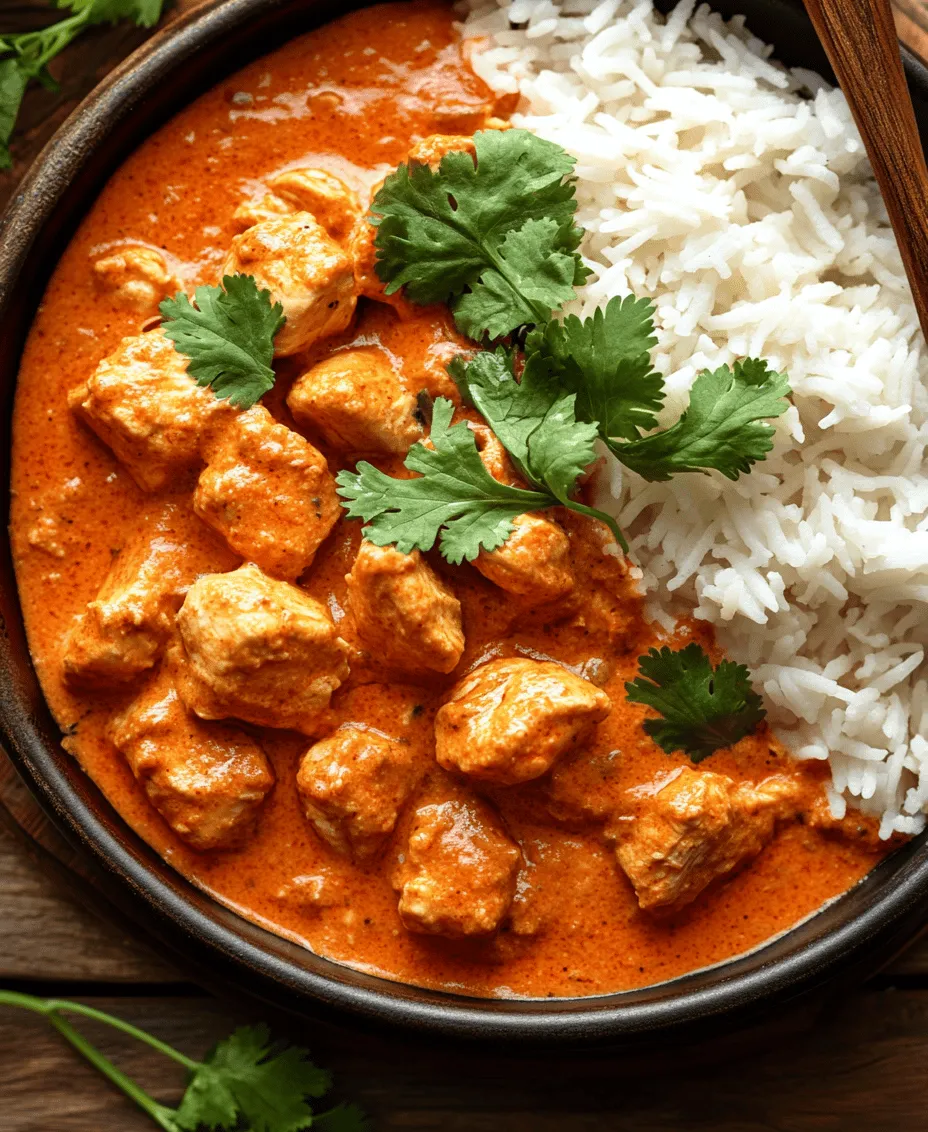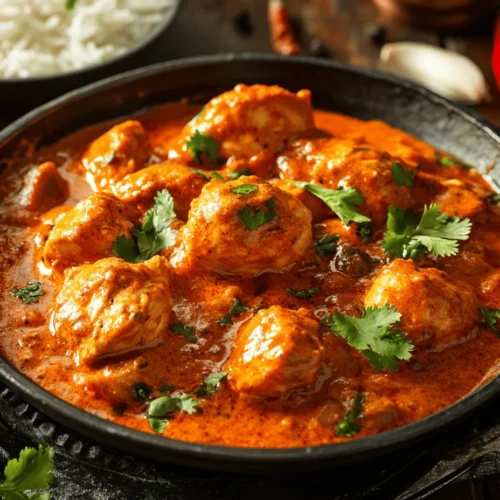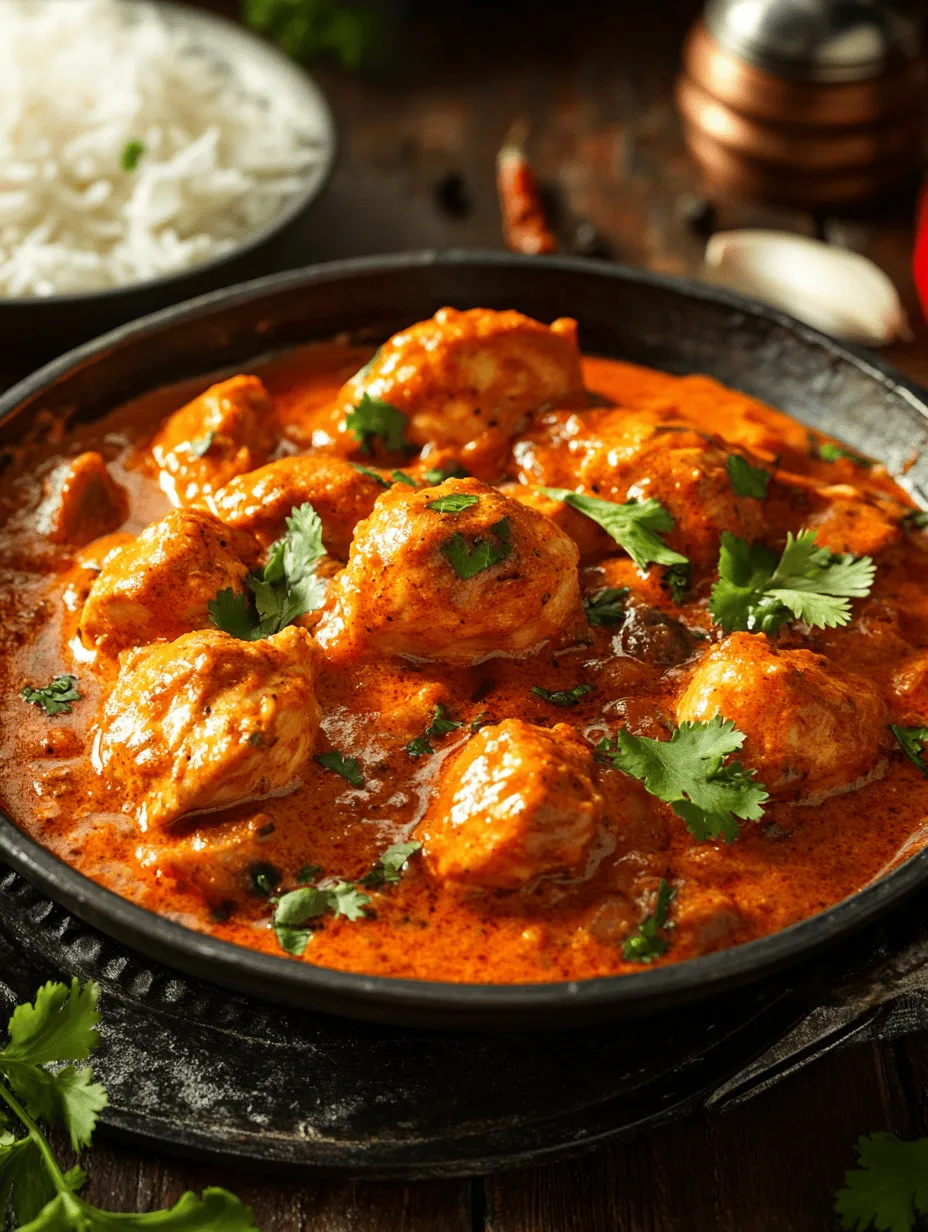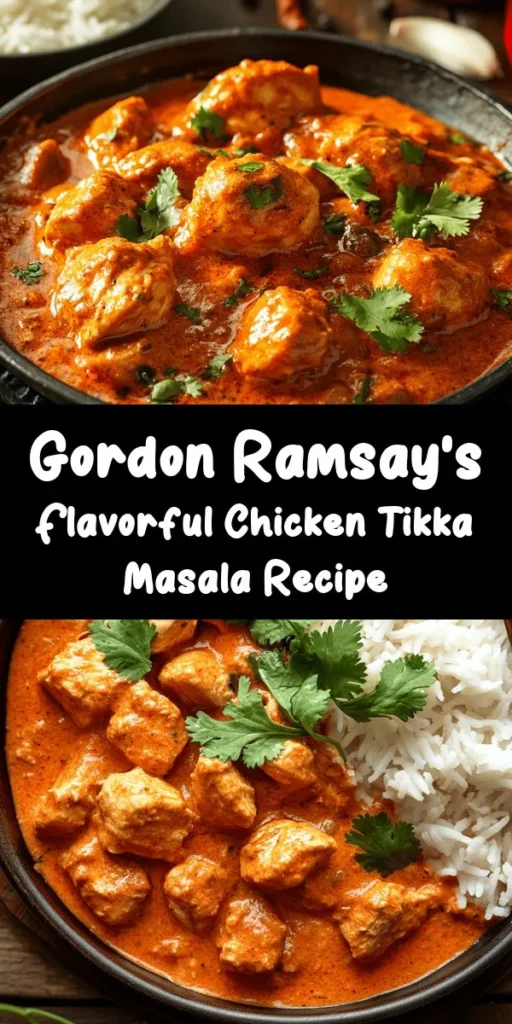Introduction
Chicken Tikka Masala is not just a dish; it’s a culinary phenomenon that has captured the hearts and taste buds of food lovers around the globe. Characterized by its vibrant orange hue and rich, aromatic flavors, this dish is a staple of Indian cuisine and has become one of the most popular choices in Indian restaurants worldwide. With its origins deeply rooted in traditional Indian cooking, Chicken Tikka Masala has also found a significant place in British cuisine, often hailed as a national dish in the UK.
When it comes to preparing Chicken Tikka Masala, Chef Gordon Ramsay takes this classic recipe to new heights. His approach emphasizes the importance of bold flavors and the meticulous use of aromatic spices, ensuring that each bite is a delightful experience. Ramsay’s recipe showcases a perfect blend of marinated chicken, infused with spices, and a luscious, creamy tomato sauce that elevates the dish to a culinary masterpiece.
Key to achieving the authentic taste of Chicken Tikka Masala is the careful attention to cooking techniques and the marination process. The marinated chicken is grilled to perfection, which not only enhances its flavor but also adds a smoky depth that is essential to this dish.
Understanding Chicken Tikka Masala
Historical Context
The origins of Chicken Tikka Masala are somewhat murky, with various claims to its creation. While it is widely believed that this dish was developed by South Asian chefs in the UK, the exact point of inception remains a topic of debate. Some attribute its creation to the 1960s when Indian restaurants began to flourish in Britain, while others argue that the dish has roots extending back to traditional Indian cooking practices.
What is widely accepted is that Chicken Tikka Masala represents a fusion of culinary traditions. The dish is a combination of Chicken Tikka, which consists of marinated and grilled chicken pieces, and a rich, creamy masala sauce made from tomatoes and spices. Over the years, Chicken Tikka Masala has evolved, with various interpretations and adaptations appearing across different cultures and regions, each bringing its unique twist to the classic recipe.
Key Components of Chicken Tikka Masala
At the heart of Chicken Tikka Masala are its two main components: the marinated chicken and the creamy tomato sauce.
1. Marinated Chicken: The chicken is typically marinated in a mixture of yogurt and spices, allowing it to absorb the flavors and become tender. This marination process is crucial; it not only enhances the taste but also helps to keep the chicken juicy during cooking.
2. Creamy Tomato Sauce: The sauce, often referred to as the masala, is a harmonious blend of tomatoes, cream, and a medley of spices. The creaminess of the sauce balances the spices, creating a rich and satisfying dish.
The popularity of Chicken Tikka Masala is not just limited to its taste; it also reflects the growing fusion of culinary traditions, showcasing how ingredients and cooking styles can transcend cultural boundaries. Variations of the dish can be found in many countries, with each region adding its unique flair, whether it be through different spices, cooking techniques, or presentation styles.
Essential Ingredients for Chicken Tikka Masala
To create Gordon Ramsay’s Chicken Tikka Masala, it is essential to gather the right ingredients that will bring out the authentic flavors of this beloved dish. Below is a breakdown of the key ingredients you’ll need for both the chicken marinade and the masala sauce.
Chicken Marinade Ingredients
– Chicken: Boneless, skinless chicken thighs are often preferred for their juiciness and flavor. However, chicken breasts can also be used for a leaner option.
– Yogurt: A crucial ingredient in the marinade, yogurt acts as a tenderizer, allowing the chicken to soak up the flavors while keeping it moist during cooking. The acidity in yogurt helps to break down the proteins in the chicken, making it tender and flavorful.
– Spices: The marinade is typically seasoned with a blend of spices, including:
– Cumin: Adds a warm, earthy flavor.
– Coriander: Offers a citrusy undertone that complements the other spices.
– Garam Masala: A staple in Indian cooking, this spice blend brings depth and complexity to the dish.
– Turmeric: Provides a vibrant color and a subtle, bitter flavor.
– Chili Powder: Adds heat and spice, which can be adjusted according to personal taste.
– Lemon Juice: Freshly squeezed lemon juice not only enhances the flavor but also adds acidity, which helps in tenderizing the chicken further.
Masala Sauce Ingredients
The masala sauce is where the magic truly happens. Here’s what you’ll need:
– Onions: Finely chopped onions form the flavor base of the sauce. They are sautéed until golden brown, adding a sweet, caramelized flavor that is essential to the sauce.
– Garlic and Ginger: Minced garlic and ginger provide aromatic depth, infusing the sauce with their distinct flavors.
– Tomatoes: Fresh, ripe tomatoes or canned tomatoes can be used to create the sauce. They provide acidity and sweetness, balancing the spices.
– Coconut Milk or Cream: For a rich, creamy texture, coconut milk is often used, but heavy cream can also be an excellent alternative. This ingredient is key to achieving the signature creaminess of Chicken Tikka Masala.
– Sugar: A small amount of sugar helps to balance the acidity of the tomatoes, enhancing the overall flavor of the dish.
– Fresh Cilantro: Chopped cilantro is often used as a garnish, adding a fresh note that brings the dish together.
Using fresh, high-quality ingredients is paramount in achieving the authentic tastes associated with Chicken Tikka Masala. The rich flavors of the spices, combined with the creaminess of the sauce, create a dish that is not only satisfying but also a true representation of Indian cuisine.
Step-by-Step Guide to Preparing Chicken Tikka Masala
Marinating the Chicken
The first step in preparing Gordon Ramsay’s Chicken Tikka Masala is marinating the chicken. This process is essential for developing the deep, rich flavors that characterize this dish.
1. Prepare the Marinade: In a large mixing bowl, combine plain yogurt, lemon juice, minced garlic, grated ginger, and the array of spices—cumin, coriander, garam masala, turmeric, and chili powder. Mix well until all the ingredients are thoroughly combined.
2. Add the Chicken: Cut the chicken into bite-sized pieces and add them to the marinade. Ensure that each piece is well-coated with the marinade, as this will help in infusing the flavors.
3. Marinate: Cover the bowl with plastic wrap or a lid and refrigerate for at least 1 hour. For best results, marinate the chicken for 4 to 6 hours or even overnight. The longer the chicken marinates, the more flavorful and tender it will become.
This initial step sets the foundation for a delicious Chicken Tikka Masala, ensuring that the chicken is not only flavorful but also incredibly tender. The next stages will involve grilling the marinated chicken and preparing the masala sauce, bringing all the elements together for a truly delightful meal.

Tips for Achieving the Perfect Marinade Consistency
The marinade is crucial in crafting a flavorful Chicken Tikka Masala. To achieve the perfect consistency, it should be thick enough to coat the chicken but still pourable. Start by using a balanced mixture of yogurt and spices. Yogurt serves as a tenderizing agent while providing a creamy base. Here are some tips to ensure the ideal marinade:
1. Use Full-Fat Yogurt: Opt for full-fat yogurt instead of low-fat versions. The creaminess enhances the flavor and helps the spices adhere better.
2. Incorporate a Variety of Spices: Use a mix of spices like cumin, coriander, turmeric, and garam masala. This not only enhances flavor but also contributes to the marinade’s thickness.
3. Add Lemon Juice: A splash of fresh lemon juice can help thin the marinade slightly while adding acidity, which balances the richness of the yogurt.
4. Mix Thoroughly: Use a whisk or fork to blend the yogurt and spices until smooth. This ensures an even distribution of flavors.
5. Let It Rest: Allow the marinade to sit for at least 30 minutes to let the flavors meld before adding the chicken.
Cooking Methods for Chicken
When it comes to cooking the marinated chicken for Chicken Tikka Masala, two popular methods are grilling and sautéing. Each has its pros and cons:
Grilling vs. Sautéing: Pros and Cons of Each Method
– Grilling:
– Pros: Grilling imparts a smoky flavor to the chicken that enhances the overall dish. It also allows excess marinade to drip away, resulting in a slightly healthier option.
– Cons: Requires outdoor equipment or a grill pan, and it can be challenging to manage the heat properly to avoid drying out the chicken.
– Sautéing:
– Pros: Sautéing is a quicker method that allows for precise control over cooking temperatures. It’s easier to achieve a nice sear on the chicken, which adds depth to the dish.
– Cons: The chicken may lose some of the smoky flavor associated with grilling, and there’s a risk of the chicken becoming dry if overcooked.
Tips for Ensuring Even Cooking and Preventing Dryness
Regardless of the cooking method chosen, there are a few essential tips to ensure the chicken cooks evenly and remains juicy:
1. Cut Uniform Pieces: If using chicken breasts, cut them into uniform pieces to promote even cooking. Aim for 1 to 2-inch cubes.
2. Marinate Overnight: For optimal flavor and tenderness, marinate the chicken overnight. This allows the spices to penetrate deeply into the meat.
3. Preheat the Cooking Surface: Ensure your grill or pan is preheated before adding the chicken. A hot surface helps to sear the meat quickly, locking in moisture.
4. Use a Meat Thermometer: Check for doneness using a meat thermometer. Chicken should reach an internal temperature of 165°F (75°C) to ensure safety and juicy results.
5. Rest the Chicken: Allow the chicken to rest for a few minutes after cooking. This helps redistribute the juices for a more succulent bite.
Creating the Masala Sauce
The Chicken Tikka Masala sauce is where the dish truly comes to life. To develop a rich, flavorful sauce, follow these steps:
Importance of Sautéing Onions to Develop Flavor
Begin by sautéing finely chopped onions in a combination of oil and butter until they are golden brown. This step is crucial as it forms the base flavor of the masala. The caramelization of onions brings out their natural sweetness, creating a depth of flavor that is essential for a great masala.
1. Choose the Right Pan: Use a heavy-bottomed pan to ensure even heat distribution. This prevents any burning and promotes the browning of the onions.
2. Cook Slowly: Allow the onions to sauté on medium heat for at least 10-15 minutes, stirring occasionally. This slow cooking process is vital for developing a rich flavor.
Techniques for Properly Incorporating Spices and Tomatoes for Depth
Once the onions are golden brown, add your spices and tomatoes:
1. Add Spices at the Right Moment: Introduce your spices (like cumin, coriander, and garam masala) after the onions are cooked. This allows the spices to bloom and release their essential oils, enhancing the overall flavor.
2. Use Fresh Tomatoes: If you can, opt for fresh tomatoes over canned. They provide a fresher flavor and better texture. Cook the tomatoes down until they break apart and meld into the sauce.
3. Simmer Gently: After adding the tomatoes and spices, allow the sauce to simmer for at least 20 minutes. This helps deepen the flavors and thickens the sauce.
Combining Chicken and Sauce
Once your chicken is cooked and the masala sauce is ready, it’s time to combine them for the ultimate flavor experience.
1. Ensure Chicken is Well-Coated: Add the cooked chicken to the simmering masala, stirring gently to coat the chicken evenly. Allow the chicken to simmer in the sauce for 5-10 minutes, letting the flavors meld and the chicken absorb the masala.
2. Adjust Seasoning and Consistency: Taste the sauce and adjust seasoning as necessary. If the sauce is too thick, add a splash of water or cream to reach the desired consistency. If it’s too thin, allow it to simmer uncovered for a few more minutes to thicken.
Serving Suggestions for Chicken Tikka Masala
Chicken Tikka Masala is best served hot and fresh, accompanied by traditional Indian staples for a complete meal.
– Traditional Accompaniments: Serve the dish with fluffy basmati rice and soft naan. The rice absorbs the sauce, making each bite flavorful, while naan is perfect for scooping up the chicken and sauce.
– Alternative Serving Ideas: For a lighter meal, consider pairing the dish with a fresh salad, cooling raita, or roasted vegetables. These options add a refreshing contrast to the rich flavors of the masala.
– Garnishing: Don’t forget to garnish your Chicken Tikka Masala with freshly chopped coriander (cilantro) before serving. This not only adds a pop of color but also a burst of fresh flavor that elevates the dish visually and taste-wise.
Nutritional Value of Chicken Tikka Masala
Chicken Tikka Masala is not just delicious; it’s also packed with nutrients.
– Overview of Nutritional Profile: A typical serving of Chicken Tikka Masala contains approximately 350-400 calories, depending on the amount of cream and oil used. It is also a good source of protein due to the chicken, with roughly 30 grams per serving.
– Benefits of Using Boneless Chicken Thighs: Opting for boneless chicken thighs adds moistness and flavor compared to chicken breasts. Thighs are generally more forgiving when cooked, reducing the likelihood of dryness.
– Health-Conscious Modifications: If you’re looking to lighten the dish, consider using light cream or yogurt instead of heavy cream. Reducing oil and using fresh tomatoes can also enhance the dish’s health profile without sacrificing flavor.
Conclusion
Making Gordon Ramsay’s Chicken Tikka Masala is a rewarding culinary experience that showcases the rich and vibrant flavors of Indian cuisine. From the marinated chicken to the luxurious masala sauce, each step contributes to an unforgettable dish. This recipe not only brings the taste of India to your kitchen but also invites you to explore the joy of cooking and sharing delicious meals with friends and family.
Embark on this culinary journey, and allow yourself to be enveloped by the aromatic spices and comforting textures of Chicken Tikka Masala. Whether enjoyed as a weeknight dinner or a special occasion meal, this dish is sure to impress. So roll up your sleeves, gather your ingredients, and dive into the wonderful world of Indian cooking!



